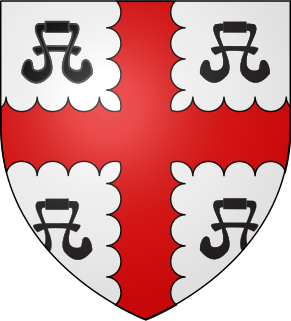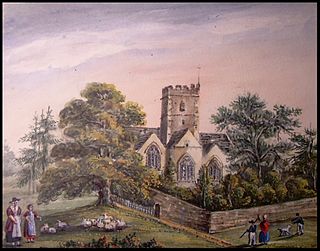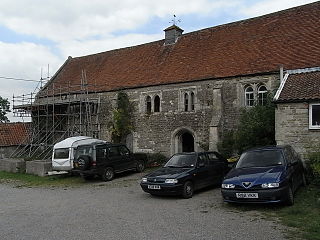Related Research Articles

Great Chalfield Manor is an English country house at Great Chalfield, about 2.5 miles (4 km) northeast of the town of Bradford on Avon in the west of the county of Wiltshire.

Walter Hungerford, 1st Baron Hungerford was an English knight and landowner, from 1400 to 1414 a Member of the House of Commons, of which he became Speaker, then was an Admiral and peer.

Sir Thomas de Hungerford of Farleigh Castle in Somerset, was the first person to be recorded in the rolls of the Parliament of England as holding the office of Speaker of the House of Commons of England, although that office had existed before his tenure.

William Edington was an English bishop and administrator. He served as Bishop of Winchester from 1346 until his death, Keeper of the wardrobe from 1341 to 1344, treasurer from 1344 to 1356, and finally as chancellor from 1356 until he retired from royal administration in 1363. Edington's reforms of the administration – in particular of royal finances – had wide-ranging consequences, and contributed to the English military efficiency in the early stages of the Hundred Years' War. As Bishop of Winchester he was responsible for starting an extensive rebuilding of Winchester Cathedral, and for founding Edington Priory, the church of which still stands today.

William Bourchier, 1st Count of Eu, was an English knight created by King Henry V 1st Count of Eu, in Normandy.

This is a list of the Sheriffs and High Sheriffs of Wiltshire.
George Pargiter Fuller, was a Liberal Party politician in the United Kingdom who sat in the House of Commons from 1885 to 1895.
Sir Walter Beauchamp was an English lawyer and Speaker of the House of Commons of England between March and May 1416.

Farleigh Hungerford Castle, sometimes called Farleigh Castle or Farley Castle, is a medieval castle in Farleigh Hungerford, Somerset, England. The castle was built in two phases: the inner court was constructed between 1377 and 1383 by Sir Thomas Hungerford, who made his fortune as steward to John of Gaunt. The castle was built to a quadrangular design, already slightly old-fashioned, on the site of an existing manor house overlooking the River Frome. A deer park was attached to the castle, requiring the destruction of the nearby village. Sir Thomas's son, Sir Walter Hungerford, a knight and leading courtier to Henry V, became rich during the Hundred Years War with France and extended the castle with an additional, outer court, enclosing the parish church in the process. By Walter's death in 1449, the substantial castle was richly appointed, and its chapel decorated with murals.
The Wiltshire Record Society is a text publication society in Wiltshire, England, which edits and publishes historic documents concerned with the history of Wiltshire.

Great Chalfield, also sometimes called by its Latin name of Chalfield Magna, formerly East Chalfield and anciently Much Chaldefield, is a small village and former civil parish in west Wiltshire, England, now part of Atworth parish. Its nearest towns are Melksham, about 3 miles (4.8 km) away to the northeast, and Bradford-on-Avon, at about the same distance to the southwest.
Thomas Tropenell, sometimes Tropenelle and Tropnell, was an English lawyer and landowner in Wiltshire in the west of England.
The Tropenell Cartulary is an English medieval manuscript cartulary compiled for Thomas Tropenell, a Wiltshire landowner, in the 15th century.

Gwladys ferch Dafydd Gam was a Welsh noblewoman. She was the daughter of Dafydd ap Llewelyn ap Hywel, otherwise known as Dafydd Gam, who was killed at the Battle of Agincourt in 1415.
William Haute (1390–1462) of Bishopsbourne, Kent, was an English politician.
Sir Edward Hungerford was an English landowner and politician who sat in the House of Commons in 1601.

Brook in the parish of Heywood, north of Westbury in Wiltshire, England, is an historic estate. It was the seat of Robert Willoughby, 1st Baron Willoughby de Broke, KG, an important supporter of King Henry VII, whose title unusually incorporates the name of his seat, in order to differentiate him from his ancestors Barons Willoughby of Eresby, seated at Eresby Manor near Spilsby in Lincolnshire. A medieval wing survives of the mansion house known as Brook Hall, a Grade I listed building which stands near the Biss Brook.

John Eyre was an English politician.

Sir Ralph Cheyne, of Brooke, in the parish of Westbury in Wiltshire, was three times a Member of Parliament for Wiltshire and was Deputy Justiciar of Ireland in 1373 and Lord Chancellor of Ireland 1383–4. He was Deputy Warden of the Cinque Ports.
Henry de la River of Tormarton in Gloucestershire was a Member (MP) of the Parliament of England for Gloucestershire in 1394.
References
- 1 2 Richmond. "ROUS, John III (d.c.1454), of Baynton in Edington, Wilts". History of Parliament Online. Retrieved 3 July 2021.
- 1 2 John Silvester Davies, ed., The Tropenell cartulary: being the contents of an old Wiltshire muniment chest, 2 vols. (Wiltshire Archaeological and Natural History Society, 1908) as text or as images